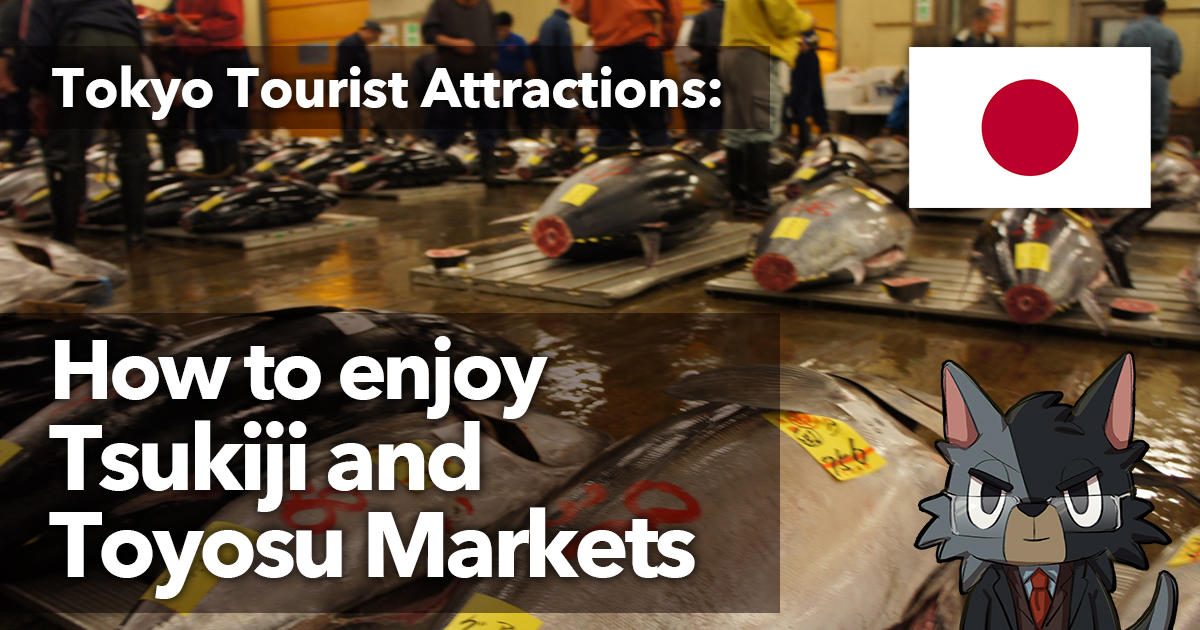Introduction
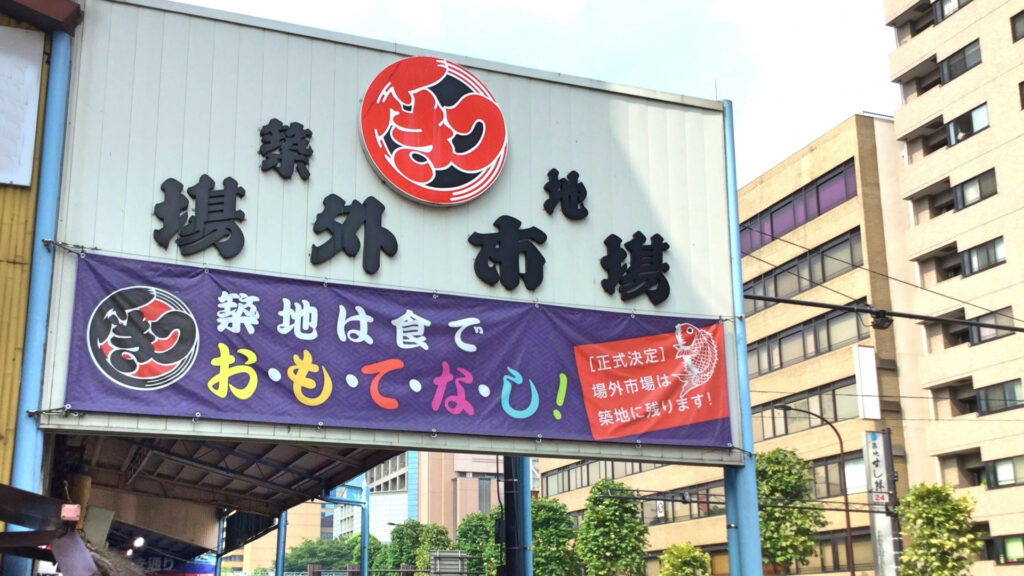
If you are visiting Tokyo, the Tsukiji and Toyosu markets are two sights you should not miss. These markets are not only a great place to enjoy fresh seafood and delicious food, but also a great place to gain a deeper understanding of Japanese food culture.
The Tsukiji Market has long been known as the food capital of Tokyo and a favorite of locals and tourists alike. Today, many stores still operate as the Tsukiji Outside Market, offering the freshest seafood, sushi, and other ingredients. The unique atmosphere and lively market scene is also worth experiencing at least once.
Meanwhile, Toyosu Market, which opened in 2018, is a modern market boasting state-of-the-art facilities and expansive grounds. Here, vendors relocated from the Tsukiji Market continue to handle high-quality seafood. The Toyosu Market has become a popular spot for visitors to experience Japanese market culture by observing tuna auctions and sampling fresh seafood at one of the many restaurants.
The appeal of the Tsukiji and Toyosu markets lies in their fresh ingredients and lively market atmosphere. By visiting these markets, you will be able to fully experience the depth and appeal of Japan’s food culture. This article provides detailed information on how to enjoy these markets to their fullest. We hope that your visit to the Tsukiji and Toyosu markets will make your trip to Tokyo even more special.
History and culture of the tourist attractions

The Tsukiji and Toyosu markets are important symbols of Japan’s food culture, each with its own unique history and culture. Here we will introduce the historical background and cultural characteristics of the Tsukiji and Toyosu markets in detail.
History and Culture of Tsukiji Market
Tsukiji Market was established in 1935 and has long served as the center of Tokyo’s food culture. Originally a market dating back to the Edo period, it developed as a place where seafood and vegetables were handled. Tsukiji Market was especially famous for its fresh seafood trade and was crowded with vendors and shoppers from early morning every day.
The cultural hallmark of the Tsukiji Market is its vibrancy and strong sense of community. Many specialty stores and eateries line the market, where visitors can enjoy sushi and seafood dishes made from the freshest seafood. For tourists, the bustling atmosphere of the Tsukiji Market and the friendly shopkeepers are a major attraction.
History and Culture of the Toyosu Market
Toyosu Market opened in 2018 as the successor to Tsukiji Market. It is a modern market with state-of-the-art facilities and a vast site, while inheriting the traditions of the Tsukiji Market. The establishment of the Toyosu Market was prompted by the aging of the Tsukiji Market and improvements in sanitation. The relocation has enabled the market to operate more hygienically and efficiently.
The cultural hallmark of the Toyosu Market is its advanced facilities and well-organized operations. The market has a dedicated observation deck where visitors can watch tuna auctions and a food court with many restaurants. Here, visitors can enjoy a market experience that draws on the traditions of the Tsukiji Market, but with the latest technology and equipment.
The history and culture of both the Tsukiji and Toyosu markets are important elements in gaining a deeper understanding of Japanese food culture. By visiting each market, you will experience the evolution of the market from the past to the present and the diversity and richness of Japan’s food culture. Experiencing the tradition of the Tsukiji Market and the innovation of the Toyosu Market, this area is one of the highlights of your visit to Tokyo and a great way to experience Japanese market culture.
Places to visit
The Tsukiji and Toyosu markets are two different attractions with many things to see and do. Here are some suggestions for the best time of year to visit, the main attractions, and some things to keep in mind when sightseeing.
Suggested times of year to visit
The best times to visit Tsukiji Market and Toyosu Market are spring and fall. Spring (March to May) offers mild weather and beautiful scenery during the cherry blossom season. Autumn (September to November) is cooler and food is abundant. In particular, autumn is a great time to enjoy fresh and delicious seafood, as many of Japan’s seasonal seafood is available.
Major tourist attractions and popular spots
The Tsukiji and Toyosu markets offer many attractive spots to visit. Below are some popular spots that you should not miss when visiting.
Tsukiji Market
- Tsukiji Outside Market: Even after the Tsukiji In-House Market moved to Toyosu, many of the stores in the Outside Market are still open. Visitors can purchase fresh seafood, sushi, and Japanese food products and eat them on the spot.
- Tsukiji Honganji Temple: Located within walking distance of Tsukiji Market, this historic temple features a unique architectural style. It is a great place to stop by between sightseeing tours of the market.
Toyosu Market
- Tuna Auction: The highlight of the Toyosu Market, the tuna auction takes place early in the morning and can be experienced from the viewing deck. Advance reservations are required, so plan your visit accordingly.
- Rooftop Garden: The Toyosu Market has a rooftop garden with beautiful views. It is the perfect place to relax and enjoy the view of Tokyo Bay and the market.
- Toyosu Market Eating & Drinking District: Enjoy fresh seafood at one of the many sushi and seafood restaurants in the district. Many of the best restaurants have relocated from Tsukiji Market, and are recommended for a full dining experience.
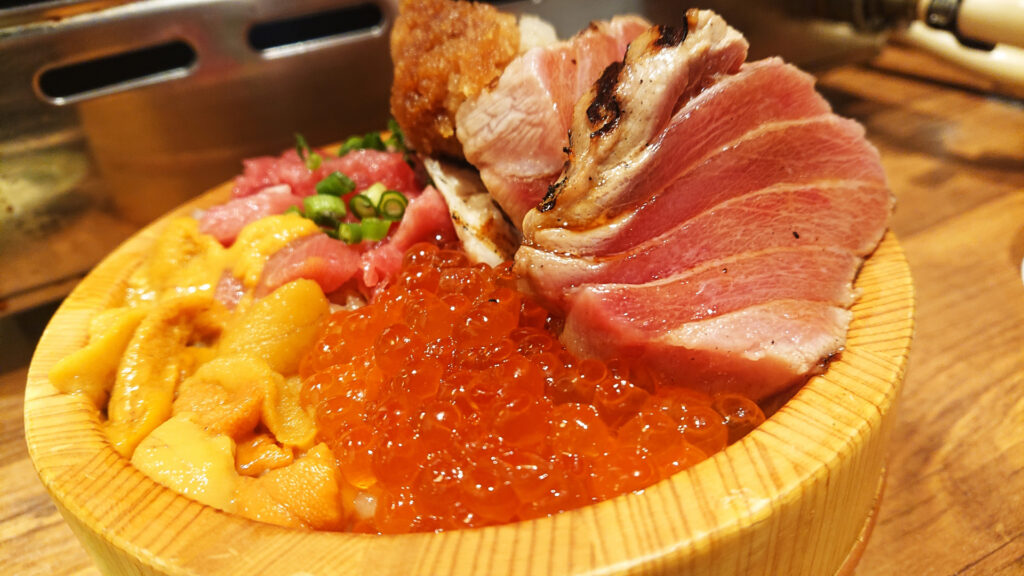
Points to note at sightseeing spots
When visiting the Tsukiji and Toyosu markets, it is best to keep in mind a few things to keep in mind.
- Visiting early in the morning: We recommend visiting early in the morning to observe the tuna auction and enjoy the fresh seafood. Early is especially important for Toyosu Market, as the market is crowded with visitors from early in the morning.
- Confirm Reservations: Advance reservations may be required to visit the Toyosu Market auction and popular restaurants. Check in advance and make a reservation before visiting.
- Hygiene Control: Hygiene control is strictly enforced in the market. Please follow the market rules and do not enter areas other than those designated for this purpose.
The Tsukiji and Toyosu markets are two very different attractions. Visit at the best time of year, enjoy the many attractions, and savor the Japanese market culture and fresh produce.
Access
The Tsukiji and Toyosu markets are located in the heart of Tokyo and are very conveniently accessible both domestically and internationally. Here we provide detailed information on how to access the markets from Tokyo Station, Narita Airport, and Haneda Airport.
Access from Tokyo Station
Access from Tokyo Station to Tsukiji Market and Toyosu Market is as follows.
Tsukiji Market
- Tokyo Metro Marunouchi Line: Take the Tokyo Metro Marunouchi Line from Tokyo Station to Ginza Station. From Ginza Station, transfer to the Tokyo Metro Hibiya Line and get off at Tsukiji Station. The trip takes about 15 minutes.
- Taxi: A cab from Tokyo Station to Tsukiji Market takes approximately 10 minutes. Taking a cab is convenient if you have a lot of luggage or if you are traveling in a group.
Toyosu Market
- Tokyo Metro Yurakucho Line: From Tokyo Station, take the Tokyo Metro Yurakucho Line, transfer at Yurakucho Station and get off at Toyosu Station. The trip takes about 20 minutes. From Toyosu Station, it is approximately a 10-minute walk to the market.
- Yurikamome: From Tokyo Station, take the JR Yamanote Line to Shinbashi Station, transfer at Shinbashi Station to the Yurikamome Line and get off at Toyosu Station. The trip takes about 30 minutes.
Access from Narita Airport
Access from Narita Airport to Tsukiji and Toyosu markets is as follows.
Tsukiji Market
- Narita Express (N’EX): Take JR Narita Express from Narita Airport and get off at Tokyo Station. From Tokyo Station, take the Tokyo Metro Marunouchi Line and Hibiya Line and get off at Tsukiji Station. It takes about 80 minutes in total.
- Limousine Bus: Take a limousine bus from Narita Airport to Tokyo City Air Terminal (TCAT), which takes about 90 minutes. 10 minutes by cab from TCAT to Tsukiji Market.
Toyosu Market
- Narita Express (N’EX): Take the JR Narita Express train from Narita Airport to Tokyo Station. From Tokyo Station, transfer to the Tokyo Metro Yurakucho Line and get off at Toyosu Station. It takes about 90 minutes in total.
- Limousine Bus: Take a limousine bus from Narita Airport to Tokyo City Air Terminal (TCAT), which takes about 90 minutes. 20 minutes by cab from TCAT to Toyosu Market.
Access from Haneda Airport
Access from Haneda Airport to Tsukiji Market and Toyosu Market is as follows.
Tsukiji Market
- Tokyo Monorail and Tokyo Metro: Take the Tokyo Monorail from Haneda Airport and get off at Hamamatsucho Station. From Hamamatsucho Station, transfer to the Toei Oedo Line and get off at Tsukiji Market Station. The trip takes about 40 minutes.
- Limousine Bus: Take a limousine bus from Haneda Airport to Tokyo City Air Terminal (TCAT), which takes about 30 minutes. 10 minutes by cab from TCAT to Tsukiji Market.
Toyosu Market
- Tokyo Monorail and Yurikamome: From Haneda Airport, take the Tokyo Monorail to Hamamatsucho Station. From Hamamatsucho Station, transfer to the Yurikamome and get off at Toyosu Station. The trip takes about 50 minutes.
- Limousine Bus: Take a limousine bus from Haneda Airport to Tokyo City Air Terminal (TCAT), which takes about 30 minutes. 20 minutes by cab from TCAT to Toyosu Market.
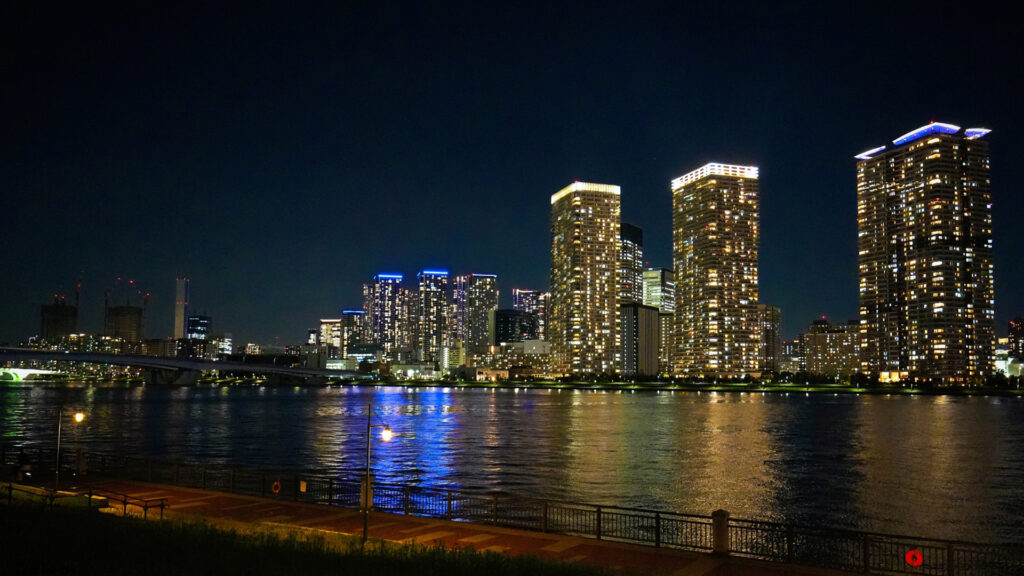
Hours of Operation, Admission Fees
When visiting the Tsukiji and Toyosu markets, it is important to check information about operating hours and admission fees in advance. Here are details about the opening hours and admission fees for both markets.
Tsukiji Market
Opening Hours.
Many of the stores in the Tsukiji Outside Market open early in the morning and are especially crowded with people looking for breakfast and fresh food. Below are the general business hours:
- Outside Market: Most stores are open from 5:00 a.m. to around 2:00 p.m., but it is recommended to check in advance as hours of operation vary from store to store.
Closed days.
- Most stores in Tsukiji Market are closed on Sundays, national holidays, and twice a month on Wednesdays (irregular holidays). It is advisable to check the business days before visiting.
Admission Fee.
- Admission to the Tsukiji Outer Market is free. Visitors are free to wander the market and enjoy shopping and dining.
Toyosu Market
Opening Hours
Like Tsukiji Market, Toyosu Market is open from early morning. You should visit early in the morning, especially if you wish to observe the tuna auction. Below are the general business hours:
- Seafood Wholesale Building: 5:00 a.m. to 5:00 p.m.
- Tuna auction viewing: 5:30 a.m. to 6:30 a.m. (the viewing deck opens at 5:00 a.m.)
- Restaurant District: Most restaurants are open from 5:00 a.m. to around 3:00 p.m., but it is recommended to check in advance as it varies from restaurant to restaurant.
Closed.
- Toyosu Market is closed on Sundays, national holidays, and market closures. Please check the official website before visiting to confirm the closing dates.
Admission.
- Admission to the Toyosu Market is free. However, advance reservations are required to observe the tuna auction, and a fee may be charged for reservations. Please check the official website for details.
Gourmet
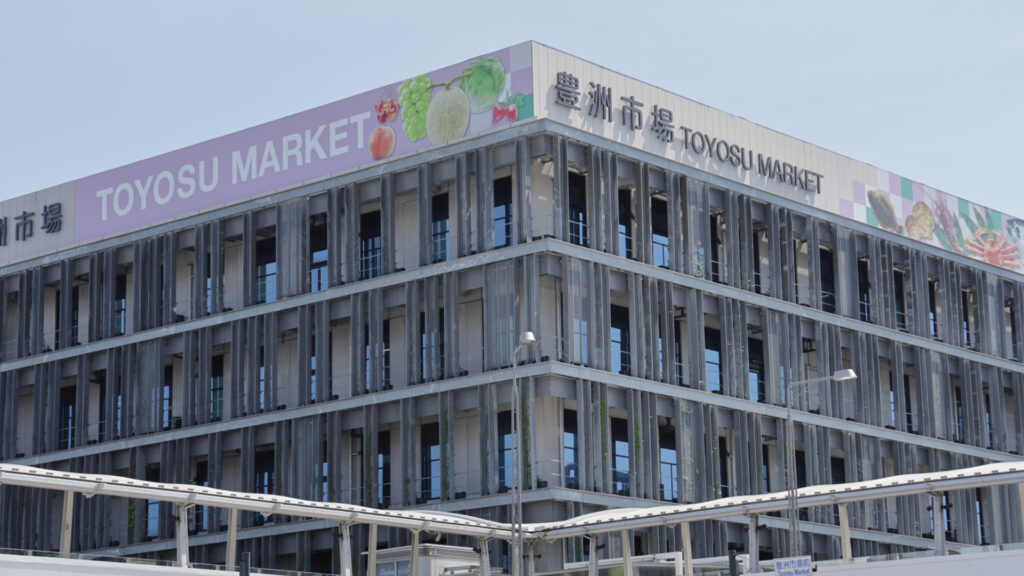
The Tsukiji and Toyosu markets are two of Tokyo’s most popular gourmet destinations, where you can enjoy exquisite cuisine made from fresh seafood. Here are some recommended dining spots and restaurants to visit.
Tsukiji Market
Recommended Restaurants at Tsukiji Market
- Sushi Dai: One of the most popular sushi restaurants in Tsukiji Market, where you can enjoy sushi made with the freshest ingredients. An early morning visit is recommended, especially as lines form early in the morning.
- Tsukiji Toradori: Kaisen-don is the specialty of this restaurant, where you can enjoy a sumptuous bowl of seafood or a bowl of sea urchin and salmon roe. The dishes are made with plenty of fresh seafood.
- Yamato Sushi: This long-established sushi restaurant in Tsukiji Market is a favorite among locals. You can enjoy the freshness of the neta and the artisanal skills of the sushi chefs.
Tsukiji Outside Market Food Recommendations.
- Tsukiji Yamacho: A traditional Japanese breakfast restaurant where you can enjoy grilled fish set meals and rice balls. The homelike taste is appealing.
- Kitsuneya: This restaurant is famous in Tsukiji Market for its horumon-don (hormone bowl). It goes great with rice.
Toyosu Market
Recommended restaurants in Toyosu Market
- Sushi Dai (Toyosu Market Branch): Relocated from Tsukiji Market, Sushi Dai is a popular spot in Toyosu Market. The sushi using fresh ingredients is superb, with tuna in particular being a specialty.
- Ajiro Ichimura: This restaurant offers tonkatsu made with fresh pork and characterized by its crispy batter and juicy meat. The hearty tonkatsu set meal is very satisfying.
Recommended Food at Toyosu Market
- Yajiman: Ramen is the specialty of this restaurant, where you can enjoy ramen noodles with seafood broth. It is a popular dish among market workers.
- Yamato Sushi (Toyosu Market Branch): This long-established sushi restaurant moved from Tsukiji Market and serves sushi with fresh ingredients. Open early in the morning, it is ideal for breakfast.
Shopping
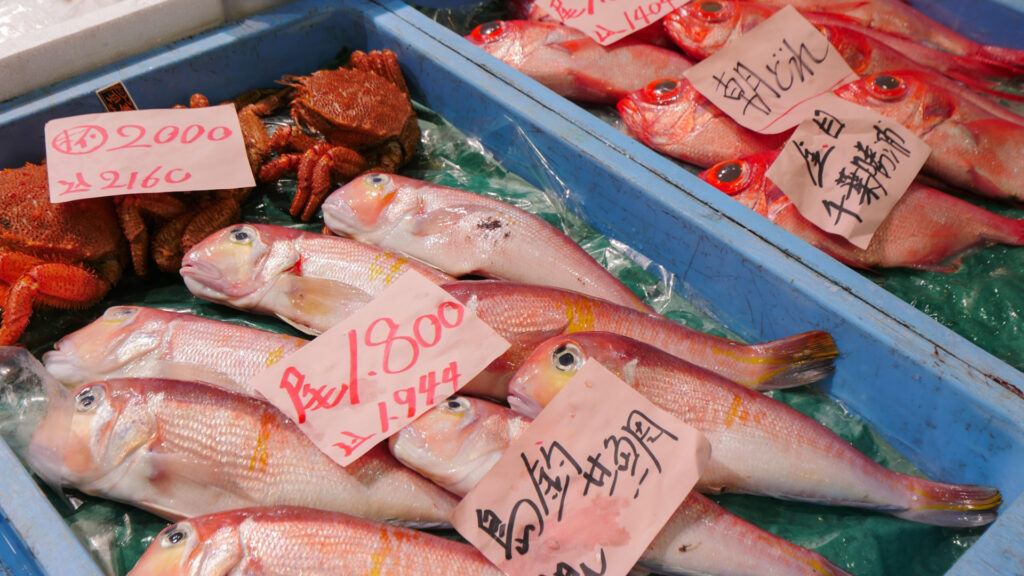
The Tsukiji and Toyosu markets are not only great areas for sightseeing, but also for shopping. Here we introduce some local specialties and products that make great souvenirs.
Tsukiji Market
Tsukiji Market Recommended Local Products
- Tsukiji Nori: Tsukiji Market is known for its high quality nori seaweed. The aromatic laver is especially suitable for onigiri (rice ball) and makizushi (rolled sushi), and makes a great souvenir.
- Dried Fish: Many dried fish products made from fresh fish are sold at Tsukiji Market. Dried horse mackerel and mackerel are a quick and easy way to enjoy the taste of Japan.
- Tsukudani: Tsukudani, a sweet-and-salty fish and seafood boiled down in soy sauce, is a perfect accompaniment to rice. At Tsukiji Market, you will find a wide variety of tsukudani on sale, allowing you to sample and choose from a wide range of tsukudani.
Recommended souvenirs from Tsukiji Outside Market
- Tsukiji Tamagoyaki: Sweet and fluffy tamagoyaki is a specialty of Tsukiji Market. The famous “Marutake” omelet is a particularly popular souvenir.
- Sushi Ko’s pickled plums: Popular at Tsukiji Market, these plums have a perfect balance of sour and sweet flavors. They keep well for a long time, making them a perfect souvenir.
Toyosu Market
Recommended Specialty Products of Toyosu Market
- Fresh Seafood: Fresh seafood can be purchased on the spot at the Toyosu Market. Tuna and crab are especially high quality and can be sent home via cool delivery.
- Fresh Fruits and Vegetables: Fresh fruits and vegetables are also available in the market. In particular, fruits in season are rich in flavor and make great souvenirs.
- Fine Wagyu Beef: In the Toyosu Market, you can also purchase fine Wagyu beef. Especially, A5 ranked Wagyu beef makes a great gift.
Recommended souvenirs from Toyosu Market.
- Tsukiji Fish Market Curry: The popular Tsukiji Fish Market Curry is also available at the Toyosu Market. Spicy and packed with seafood flavor, this curry makes a great souvenir.
- Nori tsukudani: A wide variety of seaweed tsukudani is sold at the Toyosu Market. In particular, the tsukudani products from “Tsukudani Ya Honpo” are rich in flavor and make a perfect accompaniment to rice.
Summary
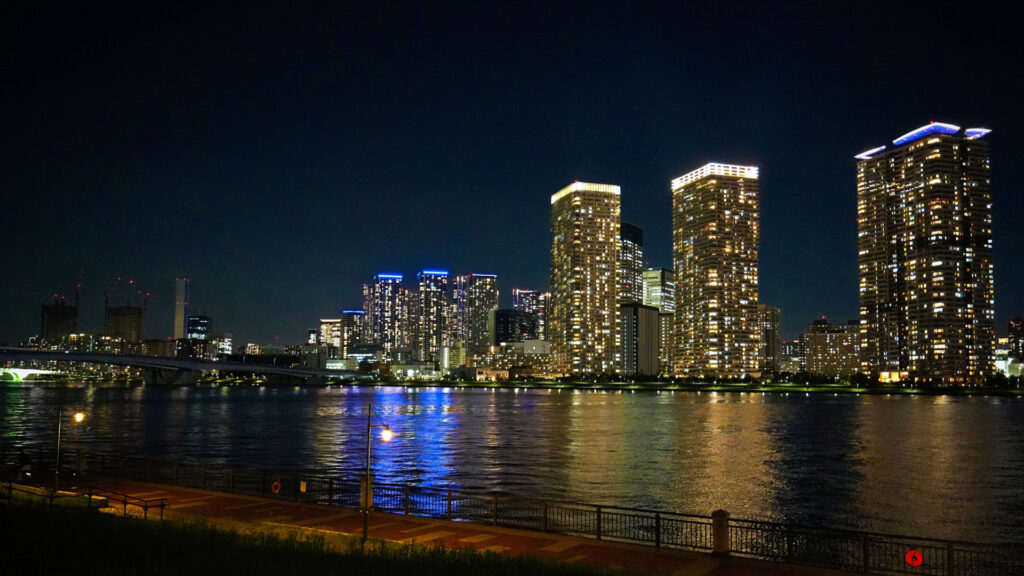
The Tsukiji and Toyosu markets are two of Tokyo’s most popular tourist attractions and great places to gain a deeper understanding of Japanese food culture. Tsukiji Market was established in 1935 and has long served as the center of Tokyo’s food culture. Today, as the Tsukiji Outside Market, it offers fresh seafood, sushi, and Japanese food ingredients, and visitors can enjoy the unique atmosphere and lively market scene.
On the other hand, Toyosu Market, which opened in 2018, is a modern market boasting state-of-the-art facilities and vast grounds. Here, vendors relocated from Tsukiji Market handle high-quality seafood, and there are many restaurants where visitors can watch tuna auctions and taste fresh seafood.
The best times to visit both markets are spring and fall, when you can enjoy the fresh and delicious seafood while enjoying the beautiful cherry blossoms and autumn leaves. They are also conveniently accessible and can be easily visited by train or limousine bus from Tokyo Station, Narita Airport, or Haneda Airport. Regarding business hours and admission fees, the Tsukiji Market is open from 5:00 a.m. to around 2:00 p.m., and the Toyosu Market is open from 5:00 a.m. to 5:00 p.m. Admission is free.
As a gourmet spot, you can enjoy excellent seafood dishes at Sushi Dai in Tsukiji Market, Sushi Dai in Toyosu Market, and many other restaurants. Shopping also allows visitors to purchase specialty products and souvenirs, such as dried seaweed and dried fish from Tsukiji, fresh seafood and produce from Toyosu, and premium wagyu beef.
A visit to the Tsukiji and Toyosu markets will make your trip to Tokyo even more special, as you will be able to fully appreciate the Japanese market culture and fresh produce.

